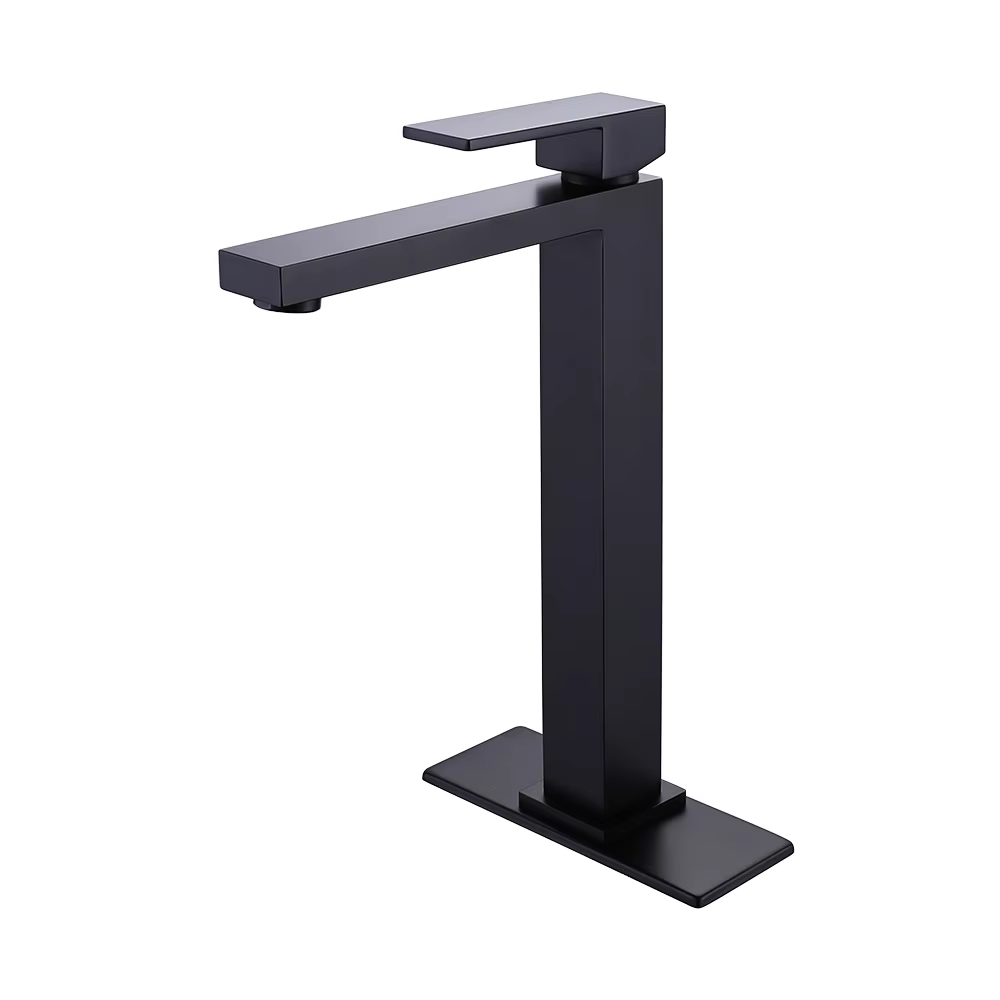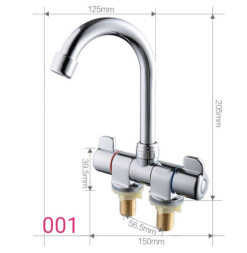What to Consider When Buying a Bathroom Faucet
A bathroom faucet is more than just a functional fixture—it enhances your bathroom’s style, affects water usage, and impacts daily comfort. With so many options available, choosing the right bathroom faucet requires considering factors like design, functionality, material, and budget. Whether you’re renovating your bathroom or replacing an old faucet, making an informed decision ensures the faucet meets your needs for years. This guide outlines key considerations when buying a bathroom faucet, helping you balance style, performance, and practicality.
Faucet Type and Mounting Style
Bathroom faucets come in different types and mounting styles, each suited to specific sinks and bathroom layouts. Understanding these options helps you choose a faucet that fits your space and needs.
- Single-Hole Faucet: A compact option with a single handle that controls both hot and cold water. It mounts through one hole in the sink or countertop, making it ideal for small vanities or pedestal sinks. Single-hole faucets are easy to install and work well in modern, minimalist bathrooms.
- Center-Set Faucet: This type has a base that covers three holes in the sink, with separate handles for hot and cold water and a spout in the center. It’s a popular choice for standard bathroom sinks with pre-drilled three-hole configurations. Center-set faucets are versatile and fit most traditional and transitional bathroom styles.
- Widespread Faucet: With separate handles and a spout that mount individually to three holes, widespread faucets offer a more elegant, spaced-out look. The holes are typically 4–8 inches apart, requiring a larger sink or countertop. They work well in larger bathrooms and complement both traditional and modern designs.
- Wall-Mounted Faucet: Mounted directly to the wall above the sink, this style frees up space on the vanity and creates a sleek, modern look. It requires plumbing inside the wall, so installation may be more complex (especially in existing bathrooms). Wall-mounted faucets are ideal for contemporary bathrooms or to highlight a unique sink design.
Check your sink or countertop’s pre-drilled holes (or wall plumbing) to ensure the bathroom faucet’s mounting style matches. Mismatched styles can lead to extra installation costs or an uneven, unappealing look.

Material and Durability
The material of a bathroom faucet determines its durability, resistance to corrosion, and long-term appearance. Choosing high-quality materials ensures the faucet withstands daily use and stays looking good.
- Brass: The most common material for bathroom faucet bodies, brass is durable, corrosion-resistant, and strong. It can be plated with other metals (like chrome or nickel) for a polished finish. Solid brass faucets are more expensive but last longer, making them a good investment.
- Stainless Steel: Resistant to rust and corrosion, stainless steel is a durable, affordable option. It’s less likely to show water spots than chrome, making it suitable for busy bathrooms. However, lower-grade stainless steel may scratch more easily than brass.
- Zinc Alloy: A cheaper alternative, zinc alloy is lighter than brass but less durable. It can corrode over time, especially in humid bathrooms, leading to leaks or a worn appearance. Zinc alloy faucets are best for temporary use or low-budget projects.
Look for faucets with a protective finish, such as chrome, brushed nickel, or matte black. Chrome is shiny and easy to clean but shows water spots. Brushed nickel has a soft, warm look and hides fingerprints. Matte black adds a modern touch and resists water spots, though it may scratch more easily. A good finish protects the faucet from tarnishing and makes maintenance easier.
Finish and Style
The finish and style of a bathroom faucet should complement your bathroom’s decor, from traditional to modern. The right choice enhances the room’s aesthetic while reflecting your personal taste.
- Traditional Styles: Features like curved spouts, cross-shaped handles, or porcelain accents characterize traditional bathroom faucets. They pair well with classic vanities, clawfoot tubs, or vintage-inspired decor. Finishes like polished brass or oil-rubbed bronze add warmth and elegance.
- Modern Styles: Sleek lines, angular spouts, and minimalist handles define modern bathroom faucets. They often have single lever handles for easy temperature control and finishes like chrome, matte black, or brushed nickel. Modern faucets work well with contemporary vanities, glass sinks, or monochromatic color schemes.
- Transitional Styles: Blending traditional and modern elements, transitional faucets offer versatility. They may have a curved spout with simple lever handles or a matte finish with subtle details. This style fits most bathrooms, from classic to updated spaces.
Consider the other fixtures in your bathroom (like towel bars, mirrors, or lighting) when choosing a finish. Matching or coordinating finishes (e.g., all brushed nickel or a mix of matte black and chrome) create a cohesive look. Avoid mixing too many finishes, as this can make the space feel cluttered.
Functionality and Features
A bathroom faucet’s functionality affects daily use, from water flow to ease of operation. Practical features enhance comfort and convenience, especially in high-use bathrooms.
- Water Flow Rate: Faucets are rated by gallons per minute (GPM). Most standard bathroom faucets have a flow rate of 1.2–2.2 GPM. Low-flow faucets (1.2 GPM or less) save water and reduce utility bills, making them eco-friendly and cost-effective. They work well in households looking to conserve water without sacrificing performance.
- Handle Type: Single-lever handles control both hot and cold water with one motion, making them easy to use (especially for children or people with limited mobility). Two-handle faucets allow precise temperature adjustment but require more space. Some faucets have touchless or motion-sensor activation, which turns water on/off with a wave of the hand—great for reducing germs and water waste.
- Spout Height and Reach: The spout’s height and reach determine how easy it is to wash hands or fill containers. A taller spout works well for vessel sinks (which sit on top of the vanity) to prevent splashing. A shorter spout is better for undermount sinks to keep water from splashing over the edge. The spout should reach far enough into the sink basin to direct water where it’s needed.
- Easy Cleaning: Faucets with smooth surfaces, fewer crevices, or a spot-resistant finish are easier to clean. Look for features like a removable aerator (the part that mixes air with water) to clean out mineral deposits, which can clog the spout over time.
Choose features that match your lifestyle: touchless for hygiene, low-flow for water savings, or a tall spout for practical use.
Installation Requirements
Installing a bathroom faucet can vary in complexity, depending on the type, existing plumbing, and whether you’re replacing an old faucet or installing a new one. Understanding installation requirements helps you budget for costs and avoid surprises.
- Existing Plumbing: If replacing an old faucet, check that the new faucet’s mounting style and hole configuration match the sink or countertop. For example, a three-hole sink may need a center-set or widespread faucet—using a single-hole faucet would leave extra holes, requiring a deck plate to cover them.
- Plumbing Access: Wall-mounted faucets require access to plumbing inside the wall, which may mean opening walls during installation (costly in existing bathrooms). Countertop-mounted faucets are easier to install if the plumbing under the sink is accessible.
- DIY vs. Professional Installation: Simple replacements (like swapping a center-set faucet with the same style) can be done by DIYers with basic tools. Complex installations (wall-mounted, new plumbing, or widespread faucets) may require a professional plumber to ensure proper alignment and prevent leaks.
Factor in installation costs when budgeting—professional installation can add $100–$300, depending on complexity. Choosing a faucet that fits your existing setup reduces installation time and costs.
Budget and Warranty
Bathroom faucets range in price from $50 to $500 or more, depending on material, brand, and features. Setting a budget helps narrow options, but balancing cost with quality ensures long-term satisfaction.
- Entry-Level (Under $100): Typically made of zinc alloy with basic finishes. These faucets work for temporary use but may corrode or leak within a few years.
- Mid-Range ($100–$300): Made of brass with better finishes (chrome, brushed nickel) and more features (low-flow, easy-clean aerators). They offer good durability for most households.
- High-End ($300+): Solid brass construction, premium finishes, and advanced features (touchless, custom styles). High-end faucets are durable, stylish, and often come with longer warranties.
A warranty is a sign of quality. Look for bathroom faucets with a warranty of 5–10 years (or lifetime) covering defects in materials or workmanship. Some brands also offer warranty coverage for finishes, protecting against tarnishing or peeling. Avoid faucets with no warranty, as they may lack quality control.
Brand Reputation and Reviews
Choosing a reputable brand ensures you’re buying a reliable bathroom faucet. Brands with a history of quality craftsmanship are more likely to stand behind their products and offer better customer support.
- Trusted Brands: Brands like Delta, Moen, Kohler, and Grohe are known for durable, well-designed bathroom faucets. They invest in testing and use high-quality materials, reducing the risk of leaks or premature wear.
- User Reviews: Read reviews from other buyers to learn about real-world performance. Look for comments on durability, ease of installation, and how well the finish holds up over time. If multiple reviews mention leaks, poor customer service, or finish issues, consider a different model.
- Customer Support: A brand with good customer support can help with installation questions, replacement parts, or warranty claims. Check if the brand offers online guides, phone support, or easy access to replacement parts.
A reputable brand with positive reviews reduces the risk of buying a faulty or short-lived bathroom faucet.
FAQ
How long should a bathroom faucet last?
With proper care, a high-quality bathroom faucet (brass construction, good finish) can last 10–15 years or more. Cheaper faucets may need replacement in 5–7 years due to corrosion or leaks.
Are touchless bathroom faucets worth it?
Yes, for hygiene and water savings. They reduce germ spread (no need to touch handles) and automatically shut off, preventing wasted water. They’re ideal for busy bathrooms or households with children.
What’s the best finish for a bathroom faucet?
Brushed nickel is popular for its durability and ability to hide fingerprints. Chrome is shiny and easy to clean but shows water spots. Matte black adds style but may scratch more easily.
Can I install a bathroom faucet myself?
Yes, if you have basic plumbing skills and the new faucet matches the existing setup. Simple replacements (same mounting style) are DIY-friendly. Wall-mounted or new plumbing may require a professional.
How do I prevent a bathroom faucet from leaking?
Choose a high-quality faucet with solid brass construction. Install it properly (tighten connections without over-tightening) and clean the aerator regularly to prevent mineral buildup. Fix small leaks promptly to avoid damage.


